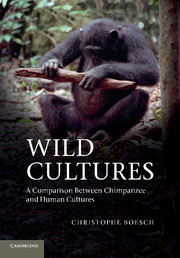Book contents
- Frontmatter
- Contents
- Acknowledgments
- Introduction
- 1 Studying culture in the wild
- 2 From human culture to wild culture
- 3 Shaping nature into home
- 4 One for all and all for one
- 5 I want to have sex with you
- 6 Learning culture
- 7 Dead or alive? Towards a notion of death and empathy
- 8 Wild culture – wild intelligence
- 9 Uniquely chimpanzee – uniquely human
- Epilogue: Will we have the time to study chimpanzee culture?
- References
- Index
3 - Shaping nature into home
About material culture
Published online by Cambridge University Press: 05 October 2012
- Frontmatter
- Contents
- Acknowledgments
- Introduction
- 1 Studying culture in the wild
- 2 From human culture to wild culture
- 3 Shaping nature into home
- 4 One for all and all for one
- 5 I want to have sex with you
- 6 Learning culture
- 7 Dead or alive? Towards a notion of death and empathy
- 8 Wild culture – wild intelligence
- 9 Uniquely chimpanzee – uniquely human
- Epilogue: Will we have the time to study chimpanzee culture?
- References
- Index
Summary
The most that the animal can achieve is to collect; man produces, he prepares the means of life, which without him nature would not have produced … makes the environment serve his ends, masters it.
Frederick Engels, The dialectics of nature (1934).… the monkey is not a variety of human, not only because he is unable to speak, but more so because we are sure that his kind is unable to improve, which is the specific character of the human species …
Jean-Jacques Rousseau, Discours sur l’origine de l’inégalité parmi les hommes (1755).Taï Forest, December 1990
Salomé, Falstaff’s closest female friend, is a strong, assertive mother of two sons. Her eldest, Snoopy, is Falstaff’s main hunting partner. Her youngest son, 4-year-old Sartre, is a very active, spoiled toddler, keen to make the most of his mother’s generosity while at the same time learning to become independent. At this time of year, some of the most abundant fruits are becoming rare and the hunting season is nearing its end. Searching for food is getting more difficult. The abundant Coula nuts are starting to ripen, but their hard shells prevent the monkeys from accessing them and the bushpigs and elephants, which have strong enough teeth to break them open, have to wait another month for the nuts to fall to the ground. However, Salomé, like the other chimpanzees, has a trick that allows her to access this very rich food source: she is able to use tools. When Salomé enters the ridge of the valley south of our camp, which I know is rich in Coula trees, she collects a hard piece of dead wood she found under a Coula tree where it had previously been used as a hammer. She puts it in her mouth and climbs up this large Coula tree. Shifting the wooden hammer into the groin of her left leg, she enters the highest, sunniest part of the tree and uses her free hand to collect eight ripe Coula nuts, which she places in her mouth. She moves to another branch and collects six more nuts, holding them in her free right foot. Then, followed by Sartre, she moves to a thicker branch higher up in the tree and begins to crack the nuts with the hammer using her left hand. She hits each seven or eight times and then, “crack,” the nut opens.
- Type
- Chapter
- Information
- Wild CulturesA Comparison between Chimpanzee and Human Cultures, pp. 47 - 80Publisher: Cambridge University PressPrint publication year: 2012



